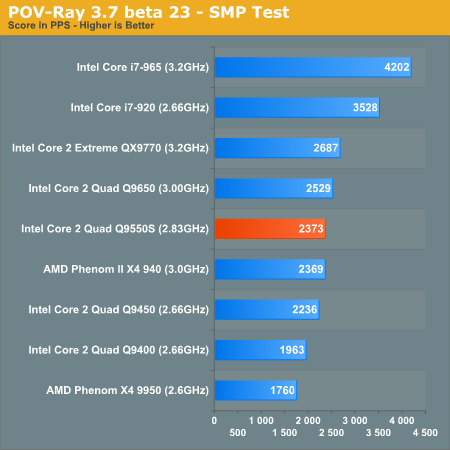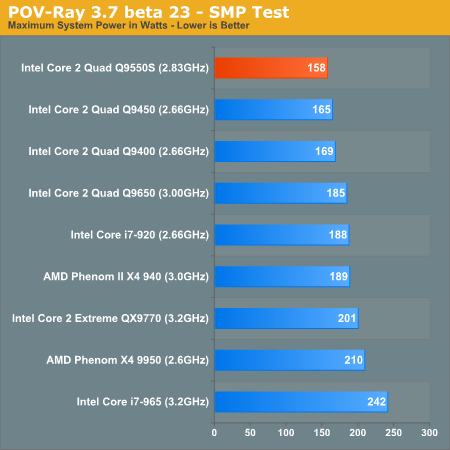Intel Core 2 Quad Q9550S: A New 65W Quad-Core
by Anand Lal Shimpi on January 27, 2009 8:00 PM EST- Posted in
- CPUs
POV-Ray 3.73 beta 23 Ray Tracing Performance
POV-Ray is a popular, open-source raytracing application that also doubles as a great tool to measure CPU floating point performance.
I ran the SMP benchmark in beta 23 of POV-Ray 3.73. The numbers reported are the final score in pixels per second.

Performance under POV-Ray shouldn’t be a surprise to anyone who’s been following the last few CPU articles here at AnandTech. The Core i7 dominates while the Phenom II is quite competitive with the quad-core Penryns. Let’s look at average power consumption:

On average, the Q9550S pulls 10 fewer watts than the Core 2 Quad Q9400, despite being 21% faster. Compared to the Q9650 the difference grows to 25W.
Peak power consumption is similarly svelte for the Q9550, we’re talking 161W at most for the entire system:

As impressive as the power numbers are however, once again we see that total energy consumed is actually lower on the Core i7 systems - by a lot.

The Core 2 Quad Q9550S used 17216J of energy during the POV-Ray test while the Core i7-920 used only 13876 joules. If you want a lower power bill, go for the i7.










62 Comments
View All Comments
UltraWide - Wednesday, January 28, 2009 - link
why was a normal 95W TDP Q9550 not included???Anand Lal Shimpi - Wednesday, January 28, 2009 - link
I didn't actually have a 95W Q9550 available (Gary has the one we used in our Phenom II review). I provided the Q9650 and the Q9450 so you can get an idea of where the Q9550 would fall.Take care,
Anand
StraightPipe - Thursday, January 29, 2009 - link
I've got to agree with UltraWide.The news is Intel just came up with the S-line of procs.
But the test doesnt compare any S to non-S CPUs...
Isnt that what really matters? the perfomance and power consumption difference between the 95W and the new 65W is what I want to see.
anandtech02148 - Wednesday, January 28, 2009 - link
finally nice to see the pick and choose Anandtech bench, need to take it out of beta, save me a trip to tomshardware.Calin - Wednesday, January 28, 2009 - link
Those processors are perfect as replacements in servers already validated for the 95W version of the same processor. While buying i7 would be better, maybe the i7 servers weren't validated (remember the 3 years of support for business-related hardware lines)danchen - Wednesday, January 28, 2009 - link
looking at the numbers, it doesn't look like its worth the extra money.Its like buying an "environmentally friendly" car - high initial investment, takes many years to get an ROI.
perhaps if you're the type who runs your computers 24/7, it may actually save you some bills in the long run.
rpsgc - Wednesday, January 28, 2009 - link
Or... you could just undervolt your current CPU. Voilà.BTW, what is the default Vcore of these processors?
WillR - Wednesday, January 28, 2009 - link
Depends on the model, but I assume you mean the likes of the Q9550. Those are 1.22V.http://www.anandtech.com/cpuchipsets/showdoc.aspx?...">http://www.anandtech.com/cpuchipsets/showdoc.aspx?... shows a few.
lucassp - Wednesday, January 28, 2009 - link
"the publicly available x264 codec (open source alternative to H.264)"firstly x264 is only an encoder, and doesn't have an encoder included. x264 is an Open Source implementation of the H.264 standard. it's not an alternative to it.
lucassp - Wednesday, January 28, 2009 - link
sorry for the mistake, I meant to say it doesn't have a decoder included ;)